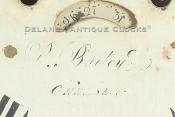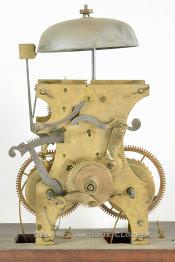Phinehaus J. Bailey. Chelsea, Vermont. An inlaid cherry case tall clock. No 6. 219117.
This important clock was made by Phinehaus J. Bailey of Chelsea, Vermont, circa 1810. This is Phinehaus's 6th clock and is so numbered.
This inlaid case is constructed in cherry and retains an older finish that has been cleaned. The result is a pleasing color that is warm and inviting. The case stands up off the floor on simple bracket feet. These are separated from the base by a thin three-line inlay. The waist section is fitted with a long rectangular-shaped waist door. The door is framed with a cross-banded border. The cross-banding is trimmed with a light line inlay. Through this door, one can access the weights and the pendulum. The front corners of the waist are fitted with reeded quarter columns. These terminate at both ends in brass quarter capitals. The hood or bonnet features a scroll top that is trimmed with an applied molding. The form exhibited in these arches is one that was used frequently in southern Vermont. They are a distinctive shape and exhibit good height. All three finial plinths support a brass ball spiked finial. The front two bonnet columns are turned and reeded. They are mounted in brass capitals. The back of the hood is fitted with smoothly turned quarter columns. The side panels feature tomb-stone shaped side lights that are fitted with glass. A delicate barber-pole inlay decorates the lower edge of the upper hood. The hood door is hinged and fitted with glass. It opens to access the dial.
This painted dial was manufactured in America. It is not an import. The four spandrel areas are decorated with colorful floral patterns. This theme is also used to decorate the lunette. The time ring is formatted with Roman-style hour numerals, Arabic five-minute markers, and dotted minutes. A subsidiary seconds dial and calendar dial are in their traditional positions within the time ring. The time is displayed or indicated by the original steel hands and seconds bit. The hour and minute hands are a form that reoccurs on other signed clocks from this region. The Maker's name and working location can be found signed just below the calendar aperture of the dial. It reads in script lettering, "P. Bailey / Chelsea."
The movement is constructed in brass. The cast brass plates are an interesting shape. They have been sculpted so the areas not being used as support have been cut away. This was a process that conserved the use of brass. The backplate is engraved with the number "6." This would indicate that this is the 6th movement that Bailey made while out on his own. The plates are supported by four ring-turned brass posts. The gearing is also brass, and the pinions are hardened steel. The movement is weight driven and designed to run for eight days on a full wind. This mechanism will strike each hour on a bell that is mounted above the plates. The strike train is a rack and snail design. The winding barrels are smooth. The movement is supported by a seaboard. The pendulum features a metal rod and a brass-faced lead bob.
This clock stands approximately 7 feet 9.5 or 92.5 inches tall to the top of the finials. When measured at the feet, this case is 21.25 inches wide and 12.25 inches deep. It was made circa 1810.
Inventory number 219117.
Phinehaus J. Bailey was born on November 6,1787 in Landaff, NH. He was the son of Asa and Abigail (Abbott) Bailey and was the fourteenth of seventeen children. In 1793, his parent recently separated, Phinehaus was sent to live with his older sister Abigail and her husband, Stephen Bartlett, in Bath. Here he received some schooling from his brother-in-law and eventually found work in his uncle's workshop making sleds, carts, crossbows, windmills, etc. In 1801, he was apprenticed to John Osgood in Haverhill, NH. Osgood was a prolific clockmaker, silversmith, and jeweler. Bailey's apprenticeship lasted seven years. In 1809, Bailey found work as a Methodist minister and journeyman in Hanover, NH, with the clockmaker, watchmaker, and silversmith Jedidiah Baldwin. This lasted approximately 7 months. Bailey did not like Baldwin, so he moved about 20 miles northeast to Chelsea, VT. Here he struck a deal with Nathan Hale to use his tools and to make clocks. This partnership prospered. In August of 1810, he married Janette McArther, and together they bought a house. By 1816, his clock business had begun to fail. Competition from the wooden clock industry in Connecticut had devastated the brass clock business. The introduction of cheap wooden geared clocks put the Makers of brass geared clocks out of business. Bailey became a traveling repairman fixing for people whatever he could. He also became interested in shorthand and mastered the art. He made some improvements of his own on the process and called his version phonography. This was a form of stenography. He developed and continued to revise his own system over the following years. In doing so, he taught numerous people. This became, for a time, his major source of income. He was also a member of the Congregational ministry. In 1823, after years of study, he was licensed to preach. He began a new career in Richmond, VT. A year later, he moved to East Berkshire to preach. He also opened a school to teach shorthand, astronomy, and grammar. In 1833, he moved across Lake Champlain to preach in Beekman, NY. Troubled times in 1839, including the death of his wife, forced him to move south to Ticonderoga, NY. Eighteen months later, he was preaching in Hebron, NY. He resigned from Hebron in 1845. In 1852, he moved back to Vermont to the town of Albany with his wife, Hannah Edwards of Morrisville. He retired from the pulpit in 1860. Phinehaus died on December 14, 1861. He lies buried next to his second wife in a small cemetery in East Berkshire, Vermont.
Several tall clocks are known. A portrait of Phinehaus Bailey and a daguerreotype are in the collection of the Bennington Museum in Bennington, Vermont. A watch paper is in the collection of the American Antiquarian Society in Worcester, Massachusetts.














